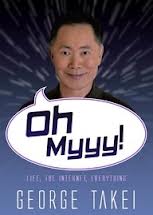Shortly after Christmas each year, I indulge in a book-buying spree. This year, one of the titles at the top of my list was George Takei’s Oh Myyy (There Goes the Internet). In addition to the fact that it’s a funny book from one of the funniest people on Facebook, it has a lot of useful information about social media. As of right now, I have a pithy observation and a serious takeaway.
First, the pithy observation (Location 134 of 1958 in the Kindle edition):
[The response to the 2011 Japan tsunami] was the first time I learned the true value and power of the social network: an open channel of communication that cannot only entertain but also unite us in a common cause, from responding to a disaster to – as the Arab Spring showed us – toppling a government.
I realize that social media and these uprisings grew up together. When there was no official channel for information, people made their own via tools like Twitter. I immediately read this sentence and considered the serious differences between the populations Takei discusses here and the population that I work with. My exact thought was this: If people who are suffering from institutional oppression at the hands of their government can use social media to overthrow a totalitarian dictatorship, just think of what a bunch of privileged milennials with smartphones can do to your department at work if given reason.
If that’s not reason enough to maintain a social media presence and work with your students on social media instead of against, I don’t know what is.
Next, the genuine takeaway. At about location 308 of 1958 in the Kindle edition:
When someone posts a meme of Yoda, many immediately share it, not just because they think it is funny … but because it says something about the sharer. It’s shorthand for saying “This little guy made a huge impact on me, not sure what it is, but for certain a huge impact. Did it make one on you too? I’m clicking ‘share’ to affirm something you may not know about me. I ‘like’ Yoda.”
The piece of advice I’ve most frequently heard about social media is that “Content is King.” It’s pretty solid advice. Why are you sharing if you have nothing to share? Without good content, there is nothing to separate you from those people you vaguely remember from childhood who post on Facebook about doing laundry or their recent trip to the grocery store. If your content is king, its packaging is the crown, and on crowded spaces like Twitter or Facebook, you can’t recognize the king without his crown.
Takei is a master of this form. He has many causes that he is passionate about, including GLBT rights, the sad history of Japanese-American internment, and the response to the 2011 tsunami. He is able to use his status as a geek icon his delightful sense of humor to share important messages. Admit it: you initially followed Takei on Twitter or liked him on Facebook because of the equivalent of a meme about Yoda that someone on your network shared with you. Since then, you’ve learned interesting things about the fight for marriage equality or about Takei’s stage production about a family affected by internment during World War II. He is able to talk about all these things as a holistic social media presence, and because he maintains himself as a personal brand, he has a lot to teach both individuals and institutions. He knows that when a person shares a joke about Yoda, they are doing two things: sharing a joke, and sharing a declaration that they are the kind of person that likes Yoda.
Karen, my supervisor, and I talk a great deal about social media and how to continue to improve our engagement with students. I think that part of the reason we have room for growth in this area is that our students look at our department as an entity that they can contact if they have a question about their housing assignment, if they require a work order, if their neighbors are making noise and they want the RA on-call to get involved, etc. Connecting with them on social media makes it easier for us to anticipate and meet these needs, but they won’t want to connect to us unless we give them Yoda. Rather than uniting geeks across location and culture the way Takei does, our challenge is to unite students with a range of interests who share a specific location: our residential communities. One of my goals for the coming year is to find our Yoda. What content can we develop or curate to assist in continued engagement, and how can we best partner it with our department and university mission?
I’m excited to read the rest of the book and keep updating. In the meantime, I highly recommend it.
